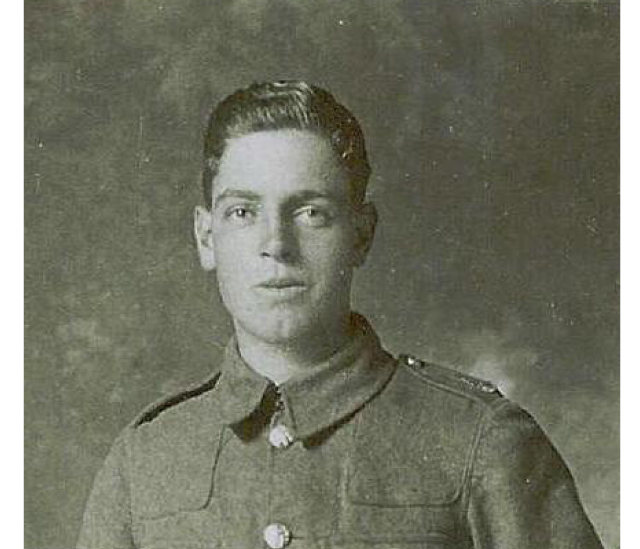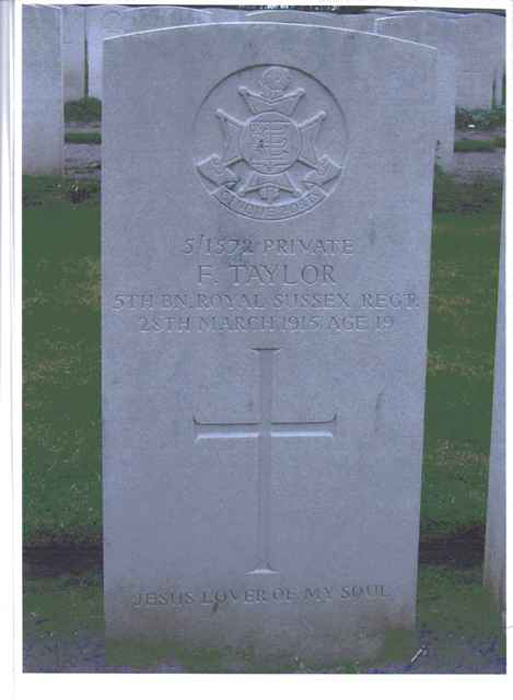Saturday 28th March 2015 marked the 100th anniversary of the death of Private Frank Taylor, Bexhill’s first Territorial to die during the First World War and the town’s 22nd war death during the conflict.
Frank Taylor lived at 6 Cumberland Road, Sidley, and before the war he worked as an Errand Boy at the grocers on Station Road owned by Mr D B McGregor. According to the Bexhill Observer in the article which reported his death, he was also well known in Sidley as a footballer and cricketer.
Frank served in the 5th Battalion of the Royal Sussex Regiment and was one of Bexhill’s Territorials who were called up in August 1914. He was serving on the Western Front when he was shot through the head by a sniper while in an advanced trench. He was just 19 years old. His parents learnt of his death through letters sent home to them from his comrades at the Front, which arrived long before the official death notice. Captain Grant wrote: “ I hope that it will comfort you to know in your great sorrow that he was killed doing his duty most gallantly in an exposed position, and that his death was absolutely painless. He was greatly liked and respected by both officers and men, and his death has caused us very great sorrow. His body was brought in the same day and properly and reverently buried, the Colonel reading the service”.
A week after Frank’s death a letter from another Bexhill soldier, Sergeant E Harman of the 5th Battalion Royal Sussex Regiment, was published in the Bexhill Observer. In his letter, he shared the sad news of the death of his friend Private Frank Taylor and spoke about the experiences that he, Frank, and other local territorials were experiencing in the trenches. “We have just returned from a spell in the trenches at the place where the British had such a brilliant success a little time ago,” says Sergeant Harman. “It was a much ‘hotter’ place than where we had been before and our front resembled a V pushed in the German lines. We had an advanced trench which was only a hundred yards from the enemy, and the worst of it was that you could be enfiladed on practically both flanks. It was a very warm ‘shop’ at times and the Huns tried to use trench mortars on us, but without much success.”
“It is with the deepest regret that I have to inform you of the death of a great friend of mine namely Private Frank Taylor, of Bexhill. He was shot through the head while in the advanced trench. He was a brave chap and was esteemed by all who knew him, and I am sure his parents have the deepest sympathy of the whole company in their sad bereavement. He was only nineteen years of age, and was killed on the 28th inst. and no man could be more greatly missed. Our other casualties, considering our position, were comparatively small, and I am certain the Germans had a warm time during the time we were in.”
Frank is buried at the Cabaret Rouge British Cemetery, Souchez. The cemetery gets its name from a café called the Cabaret Rouge which stood near to where the cemetery is now located which was destroyed by shell fire in March 1915. The café’s name was also given to a communication trench that led troops up towards the front line. Although Captain Grant states Frank was promptly and reverently buried it is likely his body was reburied at the Cabaret Rouge British Cemetery after the war by the Commonwealth Grave Commission (or the Imperial War Graves Commission as it was then). According to the Commonwealth Grave Commission, British soldiers did not begin burying their fallen comrades at the cemetery until March 1916, a year after Frank’s death. In the year’s following the war, the cemetery was expanded to accommodate as many as 7,000 relocated graves from over 100 cemeteries in the local area. It is believed Frank was reburied during this time. Frank was only 19 years old when he died, and was the 22nd Bexhill man to fall during the conflict. By the end of the War he would be followed by at least another 400 Bexhill men out of approximately 2,500 men from the town who enlisted, and after 1916 who were conscripted. Only 331 of these men are listed on the Bexhill War Memorial. Sadly Frank Taylor is not listed among them.
This story was submitted by Clare Eden, Bexhill Museum










